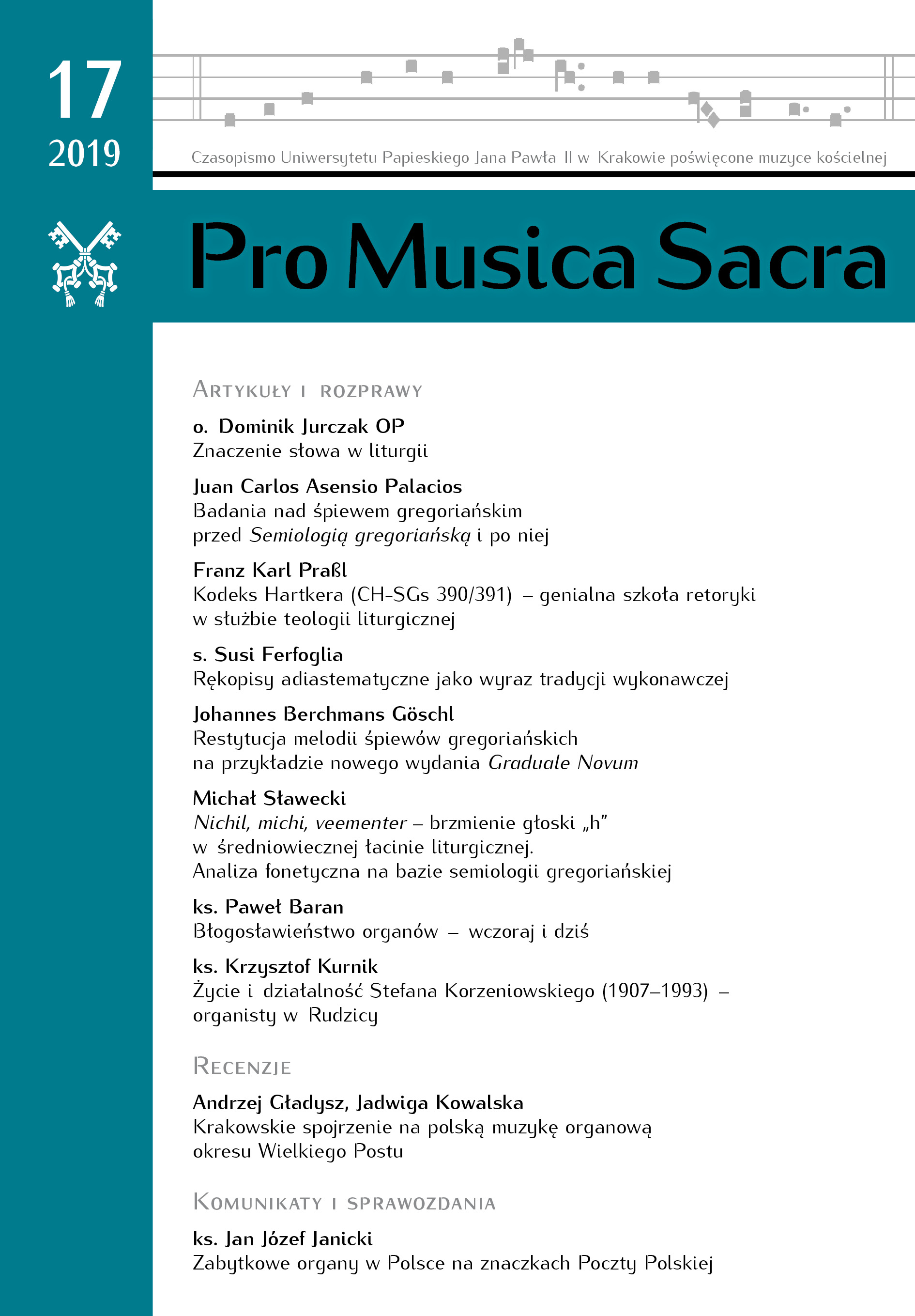Nichil, michi, veementer – brzmienie głoski „h” w średniowiecznej łacinie liturgicznej. Analiza fonetyczna na bazie semiologii gregoriańskiej
DOI:
https://doi.org/10.15633/pms.3494Słowa kluczowe:
śpiew gregoriański, paleografia muzyczna, średniowieczna łacina liturgiczna, wymowa łaciny, wymowa głoski „h” w łacinie liturgicznejAbstrakt
Podstawowym celem niniejszych badań jest zwrócenie uwagi, poprzez odniesienie
do najstarszych źródeł rękopiśmiennych, na problematykę fonetyki litery „h” w słowach,
w których głoska ta występuje pomiędzy dwoma takimi samymi samogłoskami.
Wymowa średniowiecznej łaciny kościelnej wielokrotnie była tematyką różnych studiów.
W odniesieniu do litery „h” ustalono, że nie powoduje ona żadnego dźwięku, a więc
pozostaje niema. Są jednak wyjątki od tej zasady – w słowach nihil i mihi, które prezentują
warianty ortograficzne nichil i michi powodowane wymogami fonetycznymi.
Punktem wyjścia dla badań jest założenie, że różne rękopisy należące do authenticum
fontium gregorianorum za każdym razem, gdy pomiędzy dwoma takimi samymi samogłoskami
w słowie występuje litera „h”, z racji jej bezdźwięczności powinny łączyć dwie
sylaby i przyporządkowywać im jedną niepodzielną neumę (jak to się dzieje dla przykładu
w słowach tuum, meae, si iniquitatis). Ten sam fenomen powinien mieć miejsce
w słowach nihil i mihi. Analiza bazująca na rękopisach z różnych rodzin neumatycznych,
a więc Ein, Bab1, Gal1, Gal2, Gal3, Eli, Lan, Van2, Klo1, Cha1, Lav, Dij, Ben5, Yrx, Alb,
Har1–2, dowodzi, że przy obecności dwóch takich samych samogłosek oraz litery „h”
różni skrybowie w większości wypadków dzielą słowo na dwie sylaby i zapisują dwie niezależne
neumy. Poza tym w dużej grupie rękopisów spośród wyżej zacytowanych z wielką
regularnością pojawia się dwusylabowy zapis słów nichil i michi z głoską „ch” w miejsce
„h”. Fenomen ten, związany zarówno z ortografią, jak i fonetyką, stanowi dowód na to,
że mogła istnieć praktyka wymawiania „ch+i” jak „ki”. Odwrotnie w słowie vehementer
– większość rękopisów dwóm początkowym sylabom przypisuje jedną tylko neumę;
żaden z rękopisów nie pisze vechementer, za to niektóre podają wersję słowa veementer (bez
głoski „h”). Regularnie występuje również przypadek synerezy ve-he-.
Wszystkie przypadki z repertuaru Graduale Romanum, w których występują słowa
nihil lub nichil (6 razy), mihi lub michi (70 razy), vehementer (6 razy), vehementis i comprehendam
(2 razy), apprehende (2 razy), apprehendite (1 raz), irreprehensibilis (2 razy), zostały
przebadane w świetle zapisu neumatycznego. Zwrócono szczególną uwagę na konteksty
kompozycyjne neumy torculus initio debilis.
W efekcie analizy z bardzo dużym prawdopodobieństwem dowiedziono, że słowa
nihil i mihi, nawet jeśli zapisane przy użyciu głoski „h”, wymawiano jak nichil i michi.
Bibliografia
Fournier D., Concordance textuelle du Graduale Romanum Triplex et des versets de l’Offertoriale
Triplex, Solesmes 1996.
Guilmard J.-M., Guida pratica di canto gregoriano, Saronno 2008.
Le Graduel Romain, édition critique par les moines de Solesmes, II, Les Sources, Solesmes 1957.
Milanese G., Concordantia et instrumenta lexicographica ad Graduale Romanum pertinentia,
Genova–Savona 1996.
Milanese G., La pronuncia del latino e il canto gregoriano: note d’insieme presso, „Studi Gregoriani”
(2015), s. 63–82.
Mocquereau A., Le nombre musical grégorien, t 2, Solesmes 1927.
Proposte per la restituzione di melodie del Graduale Romanum (traduzione dal tedesco di
Nino Albarosa), a cura di L. Agustoni, R. Fischer †, J. Berchmans Göschl, L. Koch,
H. Rumphorst, „Studi Gregoriani” 16 (2000), s. 59–100.
The Liber Usualis with introduction and rubrics in English, (ed. by the Benedictines of Solesmes,
Tournai–New York 1934.
Turco A., Neuma i modus, cz. 1 tłum. M. Sławecki, „Thesaurus Musicae Sacrae” 1 (2017),
s. 7–48.
Pobrania
Opublikowane
Numer
Dział
Licencja
Autorzy publikujący w czasopiśmie udzielają jego wydawcy zgody o następującej treści:
- Autor zachowuje autorskie prawa majątkowe do utworu, a jednocześnie udziela wydawcy czasopisma zgody na jego pierwszą publikację w wersji drukowanej i wersji online na licencji Creative Commons Uznanie autorstwa 4.0 Międzynarodowe oraz zgody na wykonywanie opracowań, w tym przekładów.
- Autor ma możliwość udzielania zgody niewyłącznej na opublikowanie utworu w wersji, która ukazała się w czasopiśmie (np. zamieszczenia go w repozytorium instytucjonalnym lub opublikowania w książce), wraz z informacją o jego pierwszej publikacji w czasopiśmie.
- Autor może umieścić swój utwór online (np. w repozytorium instytucjonalnym lub na swojej stronie internetowej) jeszcze przed zgłoszeniem utworu do czasopisma.

